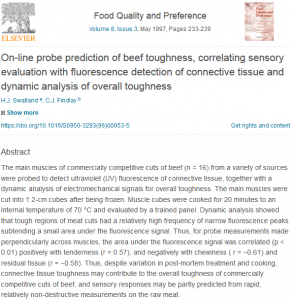On-line probe prediction of beef toughness, correlating sensory evaluation with fluorescence detection of connective tissue and dynamic analysis of overall toughness
 The main muscles of commercially competitive cuts of beef (n=16) from a variety of sources were probed to detect ultraviolet (UV) fluorescence of connective tissue, together with a dynamic analysis of electromechanical signals for overall toughness. The main muscles were cut into 1.2cm cubes after being frozen. Muscle cubes were cooked for 20 minutes to an internal temperature of 70 ºC and evaluated by a trained panel.
The main muscles of commercially competitive cuts of beef (n=16) from a variety of sources were probed to detect ultraviolet (UV) fluorescence of connective tissue, together with a dynamic analysis of electromechanical signals for overall toughness. The main muscles were cut into 1.2cm cubes after being frozen. Muscle cubes were cooked for 20 minutes to an internal temperature of 70 ºC and evaluated by a trained panel.
Dynamic analysis showed that tough regions of meat cuts had a relatively high frequency of narrow fluorescence peaks subtending a small area under the fluorescence signal. Thus, for probe measurements made perpendicularly across muscles, the area under the fluorescence signal was correlated (p<0.01) positively with tenderness (r=0.57), and negatively with chewiness (r=-0.61) and residual tissue (r=-0.58).
Thus, despite variation in post-mortem treatment and cooking, connective tissue toughness may contribute to the overall toughness of commercially competitive cuts of beef, and sensory responses may be partly predicted from rapid, relatively non-destructive measurements on the raw meat.
![]()
Swatland, H. J., & Findlay, C. J. (1997). On-line probe prediction of beef toughness, correlating sensory evaluation with fluorescence detection of connective tissue and dynamic analysis of overall toughness. Food Quality and Preference, 8 (3) 233-239. http://dx.doi.org/10.1016/S0950-3293(96)00053-5